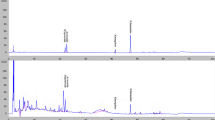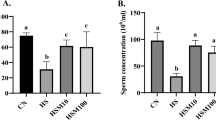Abstract
Heat stress can cause testicular damage and affect male fertility. Tanshinone IIA (TSA) is a monomer substance derived from plants, with antioxidant and anti-apoptotic effects. Whether it can repair testicular damage caused by heat stress is unclear. This study aims to construct a mouse testicular heat stress injury model and intervene with TSA. Various methods such as histopathology, high-throughput sequencing, bioinformatics analysis, and molecular biology were used to investigate whether TSA can alleviate heat stress-induced testicular injury and its mechanism. Results showed that heat stress significantly reduced the diameter of the mouse seminiferous tubules, increased cell apoptosis in the testicular tissue, and significantly decreased testosterone levels. After TSA intervention, testicular morphology and cell apoptosis improved significantly, and testosterone secretion function was restored. High-throughput transcriptome sequencing found that key differentially expressed genes between the HS group and the control and TSA groups clustered in the apoptosis and TGFβ signaling pathways. Using western blot technology, we found that the HS group upregulated TGFβ1/Smad2/Smad3 pathway protein expression, causing cell apoptosis, testicular tissue organic lesions, and affecting testicular secretion function. Through TSA intervention, we found that it can inhibit TGFβ1/Smad2/Smad3 pathway protein expression, thereby restoring testicular damage caused by heat stress. This study confirms that TSA can effectively restore testicular damage caused by heat stress in mice, possibly by inhibiting the TGFβ1/Smad2/Smad3 pathway to suppress apoptosis.



Similar content being viewed by others
References
Aldahhan RA, Stanton PG (2021) Heat stress response of somatic cells in the testis. Mol Cell Endocrinol 527:111216
Ansari MA, Khan FB, Safdari HA, Almatroudi A, Alzohairy MA, Safdari M, Amirizadeh M, Rehman S, Equbal MJ, Hoque M (2021) Prospective therapeutic potential of Tanshinone IIA: an updated overview. Pharmacol Res 164:105364
Bai L, He G, Gao C, Yang H, Li M, Huang Y, Moussa M, Xu C (2022) Tanshinone IIA enhances the ovarian reserve and attenuates ovarian oxidative stress in aged mice. Vet Med Sci 8:1617–1625
Cao X, Guo L, Zhou C, Huang C, Li G, Zhuang Y, Yang F, Liu P, Hu G, Gao X, Guo X (2023) Effects of N-acetyl-l-cysteine on chronic heat stress-induced oxidative stress and inflammation in the ovaries of growing pullets. Poult Sci 102:102274
Chen J, Bi Y, Chen L, Zhang Q, Xu L (2018) Tanshinone IIA exerts neuroprotective effects on hippocampus-dependent cognitive impairments in diabetic rats by attenuating ER stress-induced apoptosis. Biomed Pharmacother 104:530–536
Cheng Q, Zhao Y, Li J (2017) Sodium tanshinone IIA sulfonate suppresses heat stress-induced endothelial cell apoptosis by promoting NO production through upregulating the PI3K/AKT/eNOS pathway. Mol Med Rep 16:1612–1618
Ding KN, Lu MH, Guo YN, Liang SS, Mou RW, He YM, Tang LP (2023) Resveratrol relieves chronic heat stress-induced liver oxidative damage in broilers by activating the Nrf2-Keap1 signaling pathway. Ecotoxicol Environ Saf 249:114411
Fan X, Xi H, Zhang Z, Liang Y, Li Q, He J (2017) Germ cell apoptosis and expression of Bcl-2 and Bax in porcine testis under normal and heat stress conditions. Acta Histochem 119:198–204
Fang ZY, Zhang M, Liu JN, Zhao X, Zhang YQ, Fang L (2020) Tanshinone IIA: a review of its anticancer effects. Front Pharmacol 11:611087
Feng F, Li N, Cheng P, Zhang H, Wang H, Wang Y, Wang W (2020) Tanshinone IIA attenuates silica-induced pulmonary fibrosis via inhibition of TGF-β1-Smad signaling pathway. Biomed Pharmacother 121:109586
Fu K, Sun Y, Wang J, Cao R (2022) Tanshinone IIa alleviates LPS-induced oxidative stress in dairy cow mammary epithelial cells by activating the Nrf2 signalling pathway. Res Vet Sci 151:149–155
Fuchs Y, Steller H (2011) Programmed cell death in animal development and disease. Cell 147:742–758
Gonçalves AA, Garcia AR, Rolim Filho ST, Silva J, Melo DN, Guimarães TC, Tavares HR, Silva TVG, Souza EB, Santos S, Ohashi OM (2021) Scrotal thermoregulation and sequential sperm abnormalities in buffalo bulls (Bubalus bubalis) under short-term heat stress. J Therm Biol 96:102842
Horbelt D, Denkis A, Knaus P (2012) A portrait of transforming growth factor β superfamily signalling: background matters. Int J Biochem Cell Biol 44:469–474
Hu Y, Hu H, Yin L, Wang L, Luo K, Luo N (2023) Arachidonic acid impairs the function of the blood-testis barrier via triggering mitochondrial complex-ROS-P38 MAPK axis in hyperthermal Sertoli cells. Ecotoxicol Environ Saf 252:114598
Huang P, Hu F, Yang ZB, Pan Y, Zhou R, Yan YN, Wang HZ, Wang C (2023) Matrine regulates Th1/Th2 inflammatory responses by inhibiting the Hsp90/NF-κB signaling axis to alleviate atopic dermatitis. Kaohsiung J Med Sci 39(5):501–510. https://doi.org/10.1002/kjm2.12655
Leng J, Hou JG, Fu CL, Ren S, Jiang S, Wang YP, Chen C, Wang Z, Li W (2019) Platycodon grandiflorum Saponins attenuate scrotal heat-induced spermatogenic damage via inhibition of oxidative stress and apoptosis in mice. J Funct Foods 54:479–488
Liu W, Leng J, Hou JG, Jiang S, Wang Z, Liu Z, Gong XJ, Chen C, Wang YP, Li W (2021) Saponins derived from the stems and leaves of Panax ginseng attenuate scrotal heat-induced spermatogenic damage via inhibiting the MAPK mediated oxidative stress and apoptosis in mice. Phytother Res 35:311–323
Liu, Y. X. (2010) Temperature control of spermatogenesis and prospect of male contraception. Front Biosci (Schol Ed) 2:730–755
Lu TC, Wu YH, Chen WY, Hung YC (2022) Targeting oxidative stress and endothelial dysfunction using tanshinone IIA for the treatment of tissue inflammation and fibrosis. Oxid Med Cell Longev 2022:2811789
Rao M, Ke D, Cheng G, Hu S, Wu Y, Wang Y, Zhou F, Liu H, Zhu C, Xia W (2019) The regulation of CIRBP by transforming growth factor beta during heat shock-induced testicular injury. Andrology 7:244–250
Shadmehr S, Fatemi Tabatabaei SR, Hosseinifar S, Tabandeh MR, Amiri A (2018) Attenuation of heat stress-induced spermatogenesis complications by betaine in mice. Theriogenology 106:117–126
Shahat AM, Rizzoto G, Kastelic JP (2020) Amelioration of heat stress-induced damage to testes and sperm quality. Theriogenology 158:84–96
Shukla KK, Mahdi AA, Rajender S (2012) Apoptosis, spermatogenesis and male infertility. Front Biosci (Elite Ed) 4:746–754
Song YC, Kuo CC, Liu CT, Wu TC, Kuo YT, Yen HR (2022) Combined effects of tanshinone IIA and an autophagy inhibitor on the apoptosis of leukemia cells via p53, apoptosis-related proteins and oxidative stress pathways. Integr Cancer Ther 21:15347354221117776
Wang Z, Wang Q, Cui N, Xiao L, Wei H, Kang J, Sheng X, Qi X, Xing K, Guo Y, Ni H, Wang X (2022) Heat stress and hypoxia inhibit the secretion of androgens and induce epithelial-to-mesenchymal transition associated with activated TGF-β/Smad signalling in canine cryptorchidism. Reprod Domest Anim 57:1046–1055
Xiao L, Wang Z, Lu N, Wei H, Kang J, Yuan M, Sheng X, Qi X, Xing K, Guo Y, Wang X, Zhao J, Gao Y, Ni H (2022) Dihydrotestosterone through blockade of TGF-β/Smad signaling mediates the anti-fibrosis effect under hypoxia in canine Sertoli cells. J Steroid Biochem Mol Biol 216:106041
Zhang L, Xue K, Fan P, Chen C, Hu J, Huang J, Lu W, Xu J, Xu S, Ran J, Zhu S, Gan S (2023a) Geranylgeranylacetone-induced heat shock protein70 expression reduces retinal ischemia-reperfusion injury through PI3K/AKT/mTOR signaling. Exp Eye Res 229:109416. https://doi.org/10.1016/j.exer.2023.109416
Zhang X, Wang D, Liu J (2023b) Hypoxia-inducible factor-1α is involved in the response to heat stress in lactating dairy cows. J Therm Biol 112:103460
Zheng Y, Zhao Y, He W, Wang Y, Cao Z, Yang H, Wang W, Li S (2022) Novel organic selenium source hydroxy-selenomethionine counteracts the blood-milk barrier disruption and inflammatory response of mice under heat stress. Front Immunol 13:1054128
Zhou N, Ye Y, Wang X, Ma B, Wu J, Li L, Wang L, Wang DW, Zou Y (2017) Heat shock transcription factor 1 protects against pressure overload-induced cardiac fibrosis via Smad3. J Mol Med (Berl) 95:445–460
Acknowledgements
This work was supported by the Guangxi natural science foundation of China, under grant numbers 2019JJB14021, 2020GXNSFAA159099; doctoral research start-up fund of Guangxi university of Chinese medicine under grant number 2017BS013, Nanning scientific research and technology development program under grant number 20213024, Nanning Qingxiu district science and technology plan project under grant number 2020024, 2020025, Nanning Jiangnan district science and technology plan project under grant number 202001206, 20220620-8, scientific research and technology key R&D plan of Nanning Liangqing district under grant number 202009, 202213, 202216, Guangxi young and middle-aged teachers’ scientific research basic ability improvement project under grant number 2019KY0320.
Author information
Authors and Affiliations
Corresponding author
Ethics declarations
Competing interests
The authors declare no competing interests.
Additional information
Publisher’s note
Springer Nature remains neutral with regard to jurisdictional claims in published maps and institutional affiliations.
Rights and permissions
Springer Nature or its licensor (e.g. a society or other partner) holds exclusive rights to this article under a publishing agreement with the author(s) or other rightsholder(s); author self-archiving of the accepted manuscript version of this article is solely governed by the terms of such publishing agreement and applicable law.
About this article
Cite this article
Bai, L., Zhang, Y., Zheng, C. et al. Tanshinone IIA protects mouse testes from heat stress injury by inhibiting apoptosis and TGFβ1/Smad2/Smad3 signaling pathway. Cell Stress and Chaperones 28, 749–759 (2023). https://doi.org/10.1007/s12192-023-01367-4
Received:
Revised:
Accepted:
Published:
Issue Date:
DOI: https://doi.org/10.1007/s12192-023-01367-4




